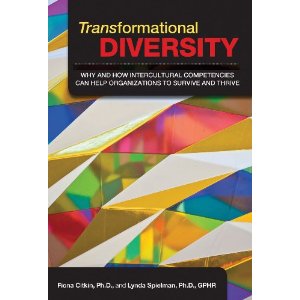
Transformational Diversity: Why and how intercultural competencies can help organizations to survive and thrive, by Fiona Citkin and Lynda Spielman, SHRM, 2011. ISBN 978-1-586-44230-9
This book had me at the title. We all work with people different from us in gender, age, function, ethnicity, nationality, intellectual orientation or religious tradition, and many of us have also been involved in mergers and acquisitions that join two or more organizational cultures. We have a wealth of diverse human talent to draw upon to penetrate new markets and creatively solve problems, but how do we do so?
Books like this one, a compendium of the latest thinking along with sample designs and resources, are gifts. Such compendia guide the responsible practitioner through the maze of information available on the topic, sifting through to highlight for the reader what is most accurate or valuable, and ideally teach us where to turn for further learning. They help us take stock of where we are as a field, where we should be going, and the latest best practice for how to get there. This book does that in a no-nonsense, practical, and brief (131 pages before appendices and bibliography) manner.
- Compete worldwide for the best talent,
- Develop global workforce initiatives,
- Coordinate all domestic efforts with an increasingly multicultural workforce,
- Have diversity contribute more visibly to performance and the bottom line, and
- Organize inclusion-oriented systematic education for all populations (p. 6).
Transformational Diversity aims to take diversity programming “beyond race and gender” (p. 1) to “more effectively enhance productivity and performance” (p. 3). The authors tell us, “Transformational Diversity is a call for change in current diversity and inclusion programs, which in our experience seems [sic] to be struggling from fatigue and from challenges to produce measurable results,” (p. 5).
What does the book have going for it?
- The fact that organizations hire “diversity” and then proceed to erase it by teaching new hires to fit in (p. 10).
- The fact that so much diversity programming is U.S.-centric (p. 13), that U.S. diversity models have “historically been grounded in… government requirements and moral ground to redress past injustices and discrimination patterns” (p. 9), and that these rarely translate well overseas.
- That affinity groups have gravitated towards social and celebratory roles, when their real value is in education: “to make known any differences represented by the individuals within the groups so that the differences can be respected, and thus, accepted” (p. 76).
- The fact that understanding the dimensions of culture is not enough. “We do not have to choose between individual and group performance but instead make sure that the relationship between them becomes meaningful in the workplace” (p. 91).
The authors share numerous helpful examples and stories. They cite several research studies and reference statistics, another plus. Their approach is always practical, such as their three steps for rolling out Transformational Diversity (pp. 38-42) or their guidance for “Exporting U.S. Diversity Programs” (pp. 68-70). Many readers will find incredible value in the six programming templates (the authors call them “Archetypes”) the authors provide (Chapter 5).
Thus, there is incredible value in this book, and I highly recommend it for all of the above reasons. The authors do a commendable job communicating basic intercultural concepts to the diversity practitioner, with advice such as helping U.S. Americans to learn to see our biases (pp. 112-114).
What would I have liked to see in this book? Adding any of the below would have added volume and complexity, and one of the most terrific things about the book is its brevity and no-nonsense approach. But, with that qualifier, I felt many of the sample solutions were still heavily knowledge-focused rather than competence-building. This would seem to me a sign of the difficulty of breaking through to new paradigms from the old. The designs in the book are excellent, and with a bit more explanation they may center on skill development, but that fact did not show through as much as I would have liked.
Secondly, as an organizational development practitioner, I was very happy to read the authors’ cautions to embed change in the organization itself (p. 73). The importance of building organizational structures and systems to support Transformational Diversity seemed to me under-emphasized, however. The six Archetypes that the authors present, though they include one on coaching, seem to focus primarily on training. What about incorporating these new commitments and capacities into our hiring, promotion, and review processes, as well as into project management and other on-the-job activities? That is my bias, of course, and no book can do it all. This one is definitely worth the read.

This book sounds very intriguing – particularly for its practicality and brevity but also for the bullets you listed, especially the one regarding the pernicious practice of proudly hiring “diversity” only to ignore inclusion (by forcing new hires to assimilate). Will have to give it a look! Thanks for sharing, Dianne.
LikeLiked by 1 person
you should post more often great read, also like the look of the blog.
LikeLiked by 1 person
Rebecca and Jeanna, thank you for your encouragement. Let us know what you think once you’ve read the book. I’m going to use it in my SIIC global diversity course this summer in Portland OR.
LikeLike
Tyhnak you for posting this Dianne!
Marie-Therese
LikeLiked by 1 person
You bet, Marie-Therese. It’s got a lot going for it. We need more “summary of current thinking” books like this, I feel. So many people want to invent something new, rather than compile and refine the best of what is….
LikeLike